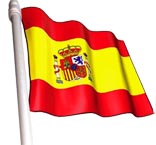Mud and thermal springs on Spain's Costa Calida
 Murcia, Spain - The white bikini stood out brilliantly against the young Spanish woman's body, whose arms, legs, abdomen and face were almost black. Though the sun beats down mercilessly on Spain's Costa Calida, or "Warm Coast," the woman's colour was not a deep suntan. She and her girlfriends had come to Lo Pagan, on the Mar Menor, to cover themselves with medicinal mud.
Murcia, Spain - The white bikini stood out brilliantly against the young Spanish woman's body, whose arms, legs, abdomen and face were almost black. Though the sun beats down mercilessly on Spain's Costa Calida, or "Warm Coast," the woman's colour was not a deep suntan. She and her girlfriends had come to Lo Pagan, on the Mar Menor, to cover themselves with medicinal mud.
Some 100 kilometres from Alicante and the beaches of Costa Blanca, the Mar Menor or "Little Sea," is a saltwater lagoon popular among sun worshippers and families with children. The area is one of Spain's warmest - in winter, too.
A spit of land about 20 kilometres long separates the Mar Menor from the Mediterranean Sea. Its waters are calm, do not exceed a depth of seven metres and are usually five degrees warmer than those on the Mediterranean side of the spit. During the summer, the hotel and holiday complexes around the Mar Menor are frequented mainly by Spaniards.
Lo Pagan, a district of San Pedro del Pinatar on the northern end of the lagoon, is known for the medicinal properties of its mud. The mud is anti-inflammatory and used to treat rheumatism, gout and arthritis as well as skin ailments such as acne.
According to signs posted on the beach promenade, "The fango layer acts like blotting paper and frees the skin from toxic substances."
The young Spanish women collected the dark mud in small plastic pails, smeared themselves with it from head to toe and rubbed it into each other's backs and faces. They were clearly having fun. Then came the obligatory walk along the promenade so that the mud could dry in the sun. Once the black paste had hardened into a grey coat, it was washed off.
The therapeutic properties of mud and salt water were utilized by the ancient Romans, who have left traces near the town of Fortuna, in the barren interior of the Murcia region. Hot thermal springs are what drew them there.
About three kilometres from Fortuna, archaeologists discovered remnants of a Roman balnearium or bath with curative water bubbling out of the ground at a temperature of 53 degrees centigrade.
The Balneario de Leana in Fortuna, one of Spain's oldest thermal baths, takes advantage of the same springs. The water is typically used to treat respiratory disorders and rheumatism but is also said to help ease simple stress.
Waders in the outdoor pool, where the water has a temperature of 34 degrees centigrade, have a view of palm trees, orchards and mountains. There is little to distract them from relaxing.
Rest is also the top priority in Archena, 18 kilometres away. In the green middle of a nature park, the Valle de Ricote, lies another thermal bath, the Balneario de Archena. Centred on a spring that attracted Spaniards as early as the 18th century, it is a modern hotel and spa complex today.
An Archena Massage is a special mud-and-water treatment. The massage bed stands under several shower heads that sprinkle warm spring water all over the person's body - except the spot the masseuse is kneading at the moment. And she uses fine mud instead of massage oil.
The area around the regional capital Murcia is known as "the nation's vegetable garden." The region is among Spain's warmest, and the Moors, who conquered the Iberian peninsula in the 8th century, devised ingenious irrigation systems to make the plains flanking the Segura River arable.
Today the region's huge fields and greenhouses are watered by the Tajo River in central Spain. More than half of its fruit and vegetables is exported.
Much of what is not goes into Murcia's cuisine. The city is known for its tasty tapas or appetizers. How about zarangollo, a scrambled egg with vegetables? Or michirones, a bean stew with chorizo? And for dessert perhaps some paparajote, deep-fried lemon tree leaves with sugar and cinnamon?
The square outside the large cathedral with the Baroque facade is a good starting point for a gourmet tour of Murcia. Alleys extending from the square lead to the historic city centre, where there are numerous taperias or places serving tapas, awaiting curious palates.
Cartagena, the second largest city in the region, is Murcia's perennial rival. A port city of some 175,000 inhabitants, it is about half as big as the regional capital. Cartagena is a popular destination for cruise passengers, who stroll through the city centre to view sights like the city hall, built in art nouveau style, and the 13th-century Santa Maria la Vieja Cathedral.
The city is especially crowded during a one-week fiesta in September, when the locals dress up as Carthaginians and Romans and parade through the streets to commemorate Cartagena's past.
Internet: www. spain. info, www. murciaturistica. es. (dpa)